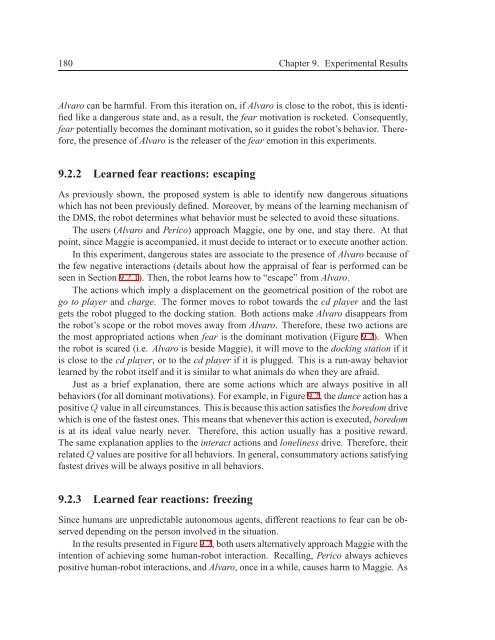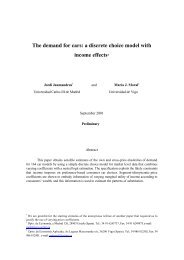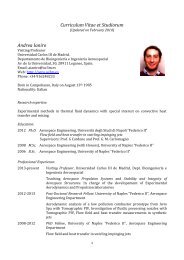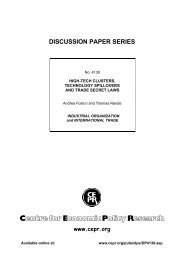TESIS DOCTORAL - Robotics Lab - Universidad Carlos III de Madrid
TESIS DOCTORAL - Robotics Lab - Universidad Carlos III de Madrid
TESIS DOCTORAL - Robotics Lab - Universidad Carlos III de Madrid
You also want an ePaper? Increase the reach of your titles
YUMPU automatically turns print PDFs into web optimized ePapers that Google loves.
180 Chapter 9. Experimental ResultsAlvaro can be harmful. From this iteration on, if Alvaro is close to the robot, this is i<strong>de</strong>ntifiedlike a dangerous state and, as a result, the fear motivation is rocketed. Consequently,fear potentially becomes the dominant motivation, so it gui<strong>de</strong>s the robot’s behavior. Therefore,the presence of Alvaro is the releaser of the fear emotion in this experiments.9.2.2 Learned fear reactions: escapingAs previously shown, the proposed system is able to i<strong>de</strong>ntify new dangerous situationswhich has not been previously <strong>de</strong>fined. Moreover, by means of the learning mechanism ofthe DMS, the robot <strong>de</strong>termines what behavior must be selected to avoid these situations.The users (Alvaro and Perico) approach Maggie, one by one, and stay there. At thatpoint, since Maggie is accompanied, it must <strong>de</strong>ci<strong>de</strong> to interact or to execute another action.In this experiment, dangerous states are associate to the presence of Alvaro because ofthe few negative interactions (<strong>de</strong>tails about how the appraisal of fear is performed can beseen in Section 9.2.1). Then, the robot learns how to “escape” from Alvaro.The actions which imply a displacement on the geometrical position of the robot arego to player and charge. The former moves to robot towards the cd player and the lastgets the robot plugged to the docking station. Both actions make Alvaro disappears fromthe robot’s scope or the robot moves away from Alvaro. Therefore, these two actions arethe most appropriated actions when fear is the dominant motivation (Figure 9.2). Whenthe robot is scared (i.e. Alvaro is besi<strong>de</strong> Maggie), it will move to the docking station if itis close to the cd player, or to the cd player if it is plugged. This is a run-away behaviorlearned by the robot itself and it is similar to what animals do when they are afraid.Just as a brief explanation, there are some actions which are always positive in allbehaviors (for all dominant motivations). For example, in Figure 9.2, the dance action has apositive Q value in all circumstances. This is because this action satisfies the boredom drivewhich is one of the fastest ones. This means that whenever this action is executed, boredomis at its i<strong>de</strong>al value nearly never. Therefore, this action usually has a positive reward.The same explanation applies to the interact actions and loneliness drive. Therefore, theirrelated Q values are positive for all behaviors. In general, consummatory actions satisfyingfastest drives will be always positive in all behaviors.9.2.3 Learned fear reactions: freezingSince humans are unpredictable autonomous agents, different reactions to fear can be observed<strong>de</strong>pending on the person involved in the situation.In the results presented in Figure 9.2, both users alternatively approach Maggie with theintention of achieving some human-robot interaction. Recalling, Perico always achievespositive human-robot interactions, and Alvaro, once in a while, causes harm to Maggie. As






